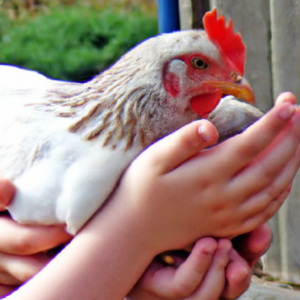
Picture this: you step into your backyard oasis, where the fresh air is filled with the gentle clucking of your beloved chickens. They seem content as they hop onto their roosting perch, but have you ever wondered if they are truly comfortable? Choosing the right roosting material for your feathered friends can make all the difference in their wellbeing. From natural branches to synthetic materials, the options may seem endless. But fear not, because in this article, we will guide you through the process of selecting the perfect roosting material for your chickens, ensuring their comfort and happiness. So let’s feather our nests and get started!
Consider the Comfort
When choosing material for your chicken coop, it’s important to consider the comfort of your chickens. After all, happy and comfortable chickens are more likely to lay eggs regularly and thrive in their environment.
Choose Suitable Materials
To ensure comfort, choose suitable materials for your chicken roosting area. Soft materials like straw or wood shavings are ideal as they provide a cushioned surface for your chickens to rest on. Avoid materials with sharp edges or splinters that could cause discomfort or injury to your feathered friends.
Provide Adequate Space
Another factor to consider for your chickens’ comfort is providing adequate space for them to roost. Make sure the roosting area is large enough for all your chickens to perch comfortably without feeling crowded. Allow at least 6-10 inches of perch space per bird, depending on the size of your flock.
Avoid Sharp or Splintered Materials
Sharp edges and splintered materials can cause discomfort and injury to your chickens’ feet. Regularly inspect your roosting material for any signs of wear or damage, and replace or repair as needed. Smooth, sturdy materials like round dowels or tree branches work well for roosting and help prevent injuries.
Consider Durability and Ease of Cleaning
When choosing roosting material for your chickens, durability and ease of cleaning are important factors to consider. You want materials that will last long and can be easily maintained.
Choose Materials that are Easy to Clean
Chickens can be messy creatures, and their roosting area can quickly become soiled with droppings. To ensure ease of cleaning, choose roosting materials that can be easily swept or scooped out, such as removable trays or trays lined with removable liners. This will save you time and effort in keeping the roosting area clean.
Select Materials that Last Long
Durability is another consideration when choosing roosting materials. Look for materials that can withstand the wear and tear of daily use and frequent cleaning. Avoid materials that may break or deteriorate easily, as this could result in a less sanitary and less comfortable environment for your chickens.
Consider Safety
Safety should be a top priority when selecting roosting materials for your chickens. Ensuring their well-being means providing an environment that minimizes potential risks and hazards.
Avoid Toxic Materials
Some materials can be toxic to chickens, so it’s crucial to avoid using them in your roosting area. Common household items like treated wood, certain paints or varnishes, and chemical-based products should be avoided. Stick to natural, non-toxic materials to keep your chickens safe and healthy.
Prevent Risk of Injury
In addition to avoiding toxic materials, it’s important to prevent any risk of injury to your flock. Avoid materials with sharp edges, nails, or screws that could potentially harm your chickens. Smooth surfaces and secure installations are essential to minimize the chance of accidents or injuries.
Consider Hygiene
Maintaining good hygiene in your chicken coop is crucial to keep your flock healthy and prevent the spread of diseases. When choosing roosting materials, consider their ability to resist moisture and provide easy-to-clean surfaces.
Choose Materials that Resist Moisture
Moisture buildup in the coop can lead to the growth of bacteria and fungus, which can be harmful to your chickens. Select roosting materials that resist moisture to minimize the risk of health issues. Moisture-resistant materials like plastic or metal can be easier to clean and maintain in the long run.
Provide Easy-to-Clean Surfaces
Regular cleaning is essential to maintain a hygienic environment for your chickens. Choose roosting materials that are easy to clean and disinfect, such as removable trays or materials that can be wiped down easily. This will help prevent the buildup of bacteria and parasites, ensuring the well-being of your flock.
Consider Cost and Availability
Considering cost-effectiveness and the availability of materials is important when planning your chicken coop. Ensuring that the chosen materials fit your budget and are easily accessible can save you time and money in the long run.
Evaluate Cost-Effectiveness
When comparing different roosting materials, evaluate the cost-effectiveness of each option. Take into account factors such as the initial cost, durability, and maintenance requirements. Opting for materials that provide long-term value and require minimal replacements can help you save money in the long term.
Ensure Availability of Materials
Before deciding on a particular roosting material, ensure its availability in your area. Some materials may be harder to find or require special ordering, which can be inconvenient and delay the setup of your chicken coop. Choose materials that are readily available to avoid unnecessary complications or delays.
Consider Nesting Boxes
If you plan to have nesting boxes in your chicken coop, there are additional considerations to keep in mind when choosing the right materials.
Use Separate Material for Nesting Boxes
Nesting boxes require different materials than the roosting area. Straw or soft wood shavings are commonly used for nesting boxes as they provide a cozy and comfortable space for your hens to lay their eggs. Separating the materials for nesting boxes and roosting areas allows for better hygiene and easier maintenance.
Provide Soft Bedding for Nesting
Comfort is crucial for your hens when they are laying eggs. Providing soft bedding materials, such as straw or wood shavings, in the nesting boxes can ensure a cozy environment for them to lay their eggs. Regularly replace the bedding to maintain cleanliness and freshness in the nesting area.
Consider Insulation
Insulation is an important factor to consider when choosing roosting materials, especially if you live in an area with extreme temperatures. Proper insulation helps regulate the temperature within the coop, keeping your chickens comfortable and healthy.
Choose Materials that Provide Insulation
Insulating materials, such as thick wood or foam, can help maintain a stable temperature inside the coop. In colder climates, insulated materials can help keep your flock warm, while in hot climates, they can provide a barrier against excessive heat. Consider the climate in your area when selecting materials for insulation.
Ensure Proper Ventilation
While insulation is important, it’s equally essential to ensure proper ventilation within the coop. Good airflow helps prevent the buildup of excessive heat or moisture, which can be detrimental to your chickens’ health. Consider materials that allow for adequate ventilation while still providing insulation.
Consider Natural and Organic Options
If you prefer a more natural and organic approach to your chicken coop setup, there are several options to consider when choosing roosting materials.
Use Natural Materials
Natural materials such as untreated wood, bamboo, or natural fibers can be great choices for roosting materials. They provide a more eco-friendly and sustainable option while ensuring the comfort and safety of your chickens. Avoid using materials with chemical treatments or additives.
Opt for Organic Bedding
If you’re focusing on organic practices, opt for organic bedding materials in your roosting area. Organic straw or wood shavings are widely available and provide a healthier environment for your chickens. Organic bedding reduces the exposure to potentially harmful chemicals or pesticides, ensuring the well-being of your flock.
Consider Pest Control
Pests can be a nuisance in any chicken coop, so it’s important to choose roosting materials that deter pests and prevent infestations.
Choose Materials that Deter Pests
Some roosting materials have natural properties that deter pests. For example, cedar wood has natural oils that repel insects. Consider using such materials in your coop to discourage pests from nesting or causing harm to your chickens. Regularly inspect and maintain your roosting materials to prevent any pest issues.
Avoid Attracting Rodents or Insects
Certain materials can attract rodents or insects, increasing the risk of infestations. Avoid using materials that attract pests, such as food scraps or untreated straw. Proper waste management and regular cleaning are essential to minimize the chances of attracting unwanted visitors to your chicken coop.
Consider Recommendations and Research
Before making any final decisions on the roosting materials for your chickens, it’s beneficial to gather recommendations, conduct research, and consider your own experiences.
Consult Local Poultry Experts
Get advice from local poultry experts or experienced chicken keepers in your area. They can provide valuable insights into the best materials for roosting and their availability. Local experts understand the specific needs and challenges of your region, ensuring that you make informed decisions.
Read Reviews and References
Read reviews and references from fellow chicken keepers or reputable sources to gather information on the effectiveness and suitability of different materials. Real-life experiences and testimonials can provide valuable information and help you make informed choices.
Take into Account Personal Experiences
If you have previous experience with certain materials, consider your own observations and knowledge. Reflect on what has worked best for your flock in the past and make any necessary adjustments based on your personal experiences. Your familiarity with your chickens’ needs can guide you in selecting the most suitable roosting materials.
Choosing the right roosting material for your chickens is an important aspect of providing a comfortable, safe, and hygienic environment for them to thrive. By considering factors such as comfort, durability, safety, hygiene, cost-effectiveness, nesting boxes, insulation, natural and organic options, pest control, and recommendations, you can make an informed decision that meets the specific needs of your flock. Remember to prioritize the well-being of your chickens and enjoy the process of creating a cozy and inviting space for your feathered friends.







